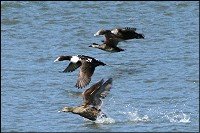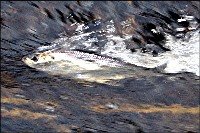 I think probably most people in North American are familiar with Chipmunks, or at least have heard of them. Let's see, what do we know about them? Well, first of all I
I think probably most people in North American are familiar with Chipmunks, or at least have heard of them. Let's see, what do we know about them? Well, first of all I  think they're cute, and the one pictured here is what we call our resident Chipmunk, for we figure it lives under our garden shed. Chipmunks are members of the Squirrel family but while squirrels make their nests in hollow trees or among tree branches, Chipmunks live in underground burrows. This small mammal, of about 9 1/2 inches long, is easily identified by the seven stripes on its back, five dark and two light.
think they're cute, and the one pictured here is what we call our resident Chipmunk, for we figure it lives under our garden shed. Chipmunks are members of the Squirrel family but while squirrels make their nests in hollow trees or among tree branches, Chipmunks live in underground burrows. This small mammal, of about 9 1/2 inches long, is easily identified by the seven stripes on its back, five dark and two light.
But back to my title question and why do I ask? And why do I answer my own question of, "Can Chipmunks swim?," by saying, "Yes". Well if you saw a Chipmunk on a rock in the middle of the river you would wonder too. How did it get there? It looks quite spry and healthy so I don't think it was prey of a large bird that might have dropped it there. And if dropped could it have been so lucky as to land on a small rock in the middle of a fair sized stream of water? I think it must have swam there.
Well if you saw a Chipmunk on a rock in the middle of the river you would wonder too. How did it get there? It looks quite spry and healthy so I don't think it was prey of a large bird that might have dropped it there. And if dropped could it have been so lucky as to land on a small rock in the middle of a fair sized stream of water? I think it must have swam there. 
I stumbled upon this Chipmunk on a rock, in the middle of a river just by chance. While standing beside the river the other day I noticed that the water was breaking in a V shape around a small object, and I had wondered if it might be a duck swimming in the water upstream. I never carry binoculars so I took a look, and a picture, through my telephoto lens to bring it closer in sight and concluded that it was only a rock. Only after I was back home downloading pictures did I see that on another rock, closer to the lower left in the photo above, was a Chipmunk!
What a fun and surprising discovery this was!
 The Eastern Kingbird is distinguished from other Kingbirds by a white tip on the end of its black tail. Kingbirds feed on insects.
The Eastern Kingbird is distinguished from other Kingbirds by a white tip on the end of its black tail. Kingbirds feed on insects.







































 The totally black bill, the dark head and the weak wing bars all led me to its identification. Also the dark smudges on the sides of its light breast indicated to me that this was an adult.
The totally black bill, the dark head and the weak wing bars all led me to its identification. Also the dark smudges on the sides of its light breast indicated to me that this was an adult.























